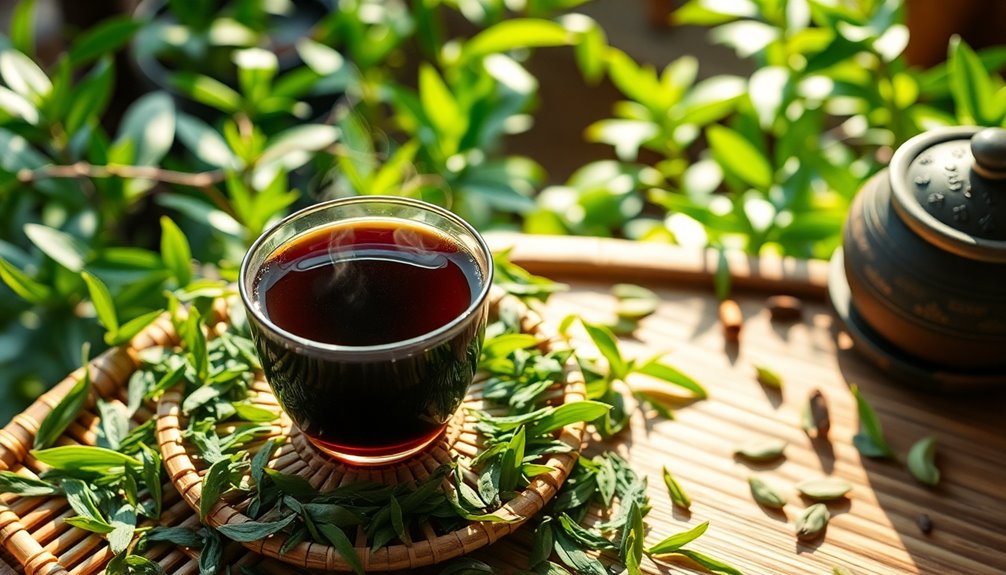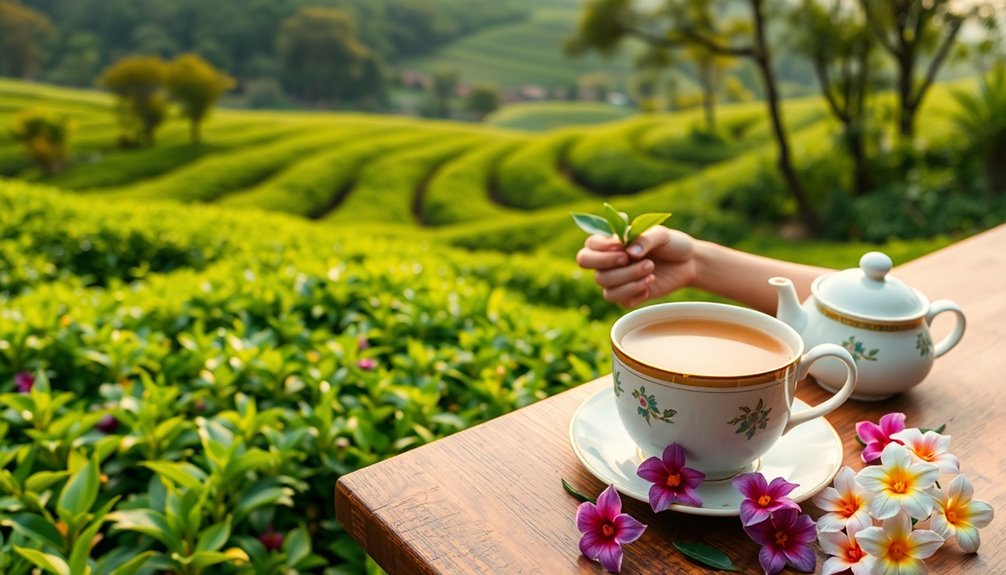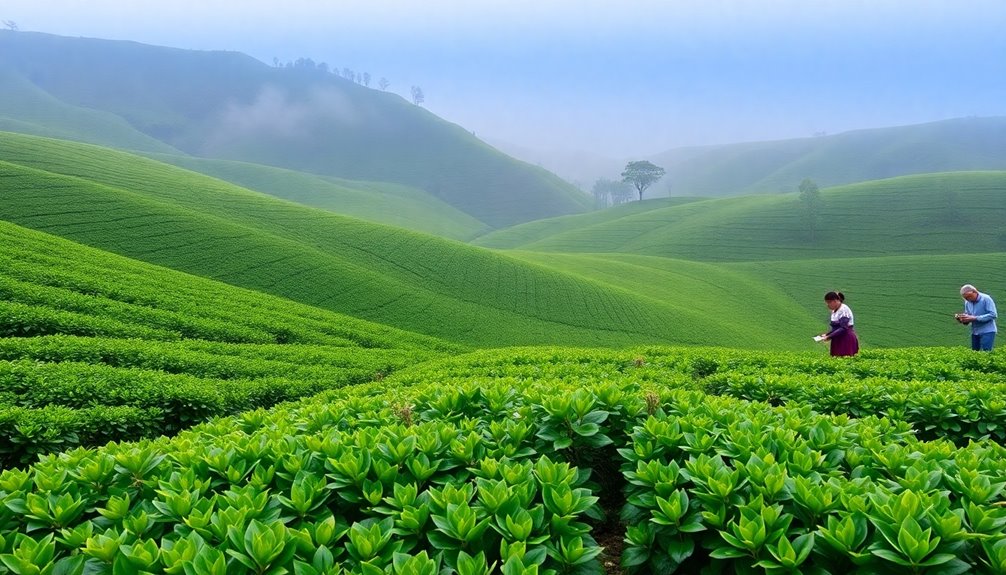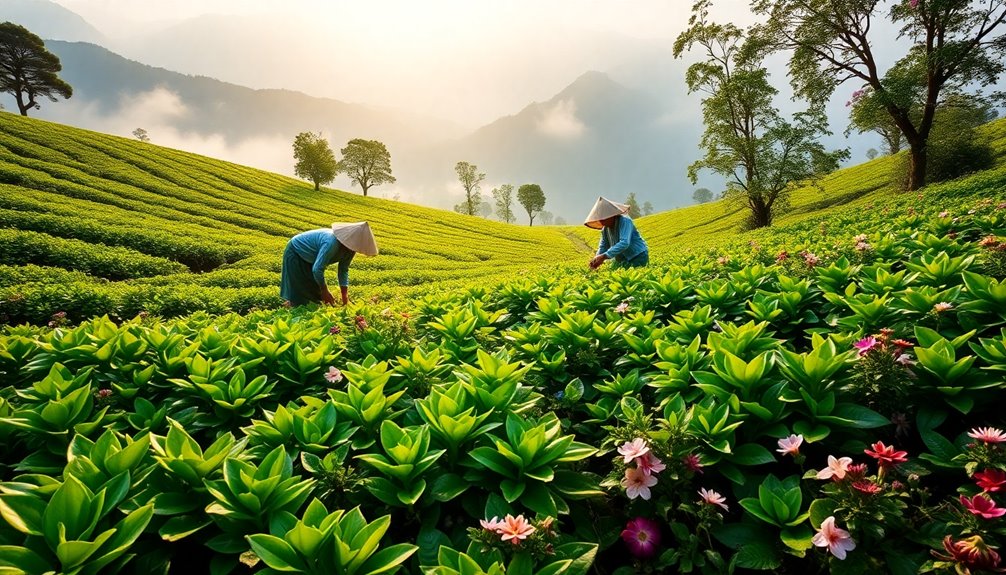Tea harvesting methods greatly affect the flavor of your favorite brew, and here's why! When tea is hand-picked, workers choose the youngest, most delicate leaves, giving your drink a superior taste and aroma. Timing matters, too! The first flush leaves picked in early spring are sweeter and packed with flavor. Plus, tea from higher altitudes often tastes better due to cooler temps and mineral-rich soil, which helps develop complex flavors. But watch out! Mechanical harvesting can mix up the leaves and harm quality. Isn't it exciting to think about how these details change your delicious cup of tea? There's even more to discover!
Key Takeaways
- Hand-harvesting selectively picks the youngest leaves, preserving superior flavor and aroma compared to mechanical methods that mix leaf qualities.
- First flush leaves are the most flavorful and nutrient-rich, making timely harvesting essential for optimal taste.
- Higher altitude growth results in denser leaves with enhanced flavor due to cooler temperatures and increased sunlight exposure.
- Traditional harvesting methods minimize damage to tea bushes, maintaining leaf quality and contributing to better tasting tea.
- Labor disputes can lead to a shift to mechanical harvesting, which compromises the quality and flavor of the final product.
Introduction
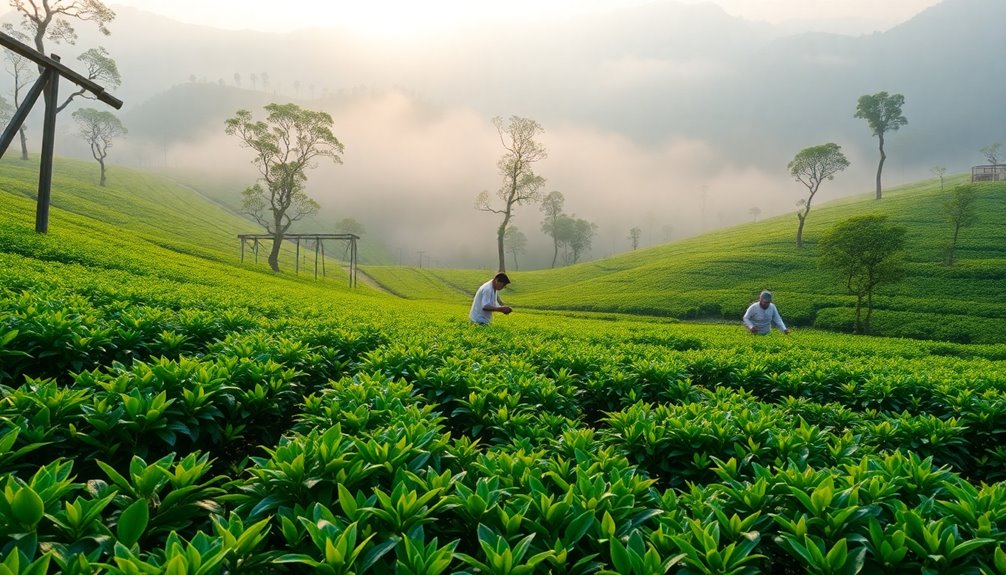
When it comes to tea harvesting, the method you choose can make all the difference in the final product. You might think that all tea is created equal, but that's not the case! Hand picking is one of the best techniques for selecting the finest tea leaves. When you hand-harvest, you can choose the youngest, most flavorful leaves, which helps create quality tea with a superior taste.
The timing of your harvest is just as important. The first flush in spring brings out the freshest leaves, packed with flavor and nutrients. Picking at the right harvest time means you'll get the best flavor of the tea. If you wait too long, the tea leaves lose their delightful qualities, and the tea can taste less exciting.
Using the right harvesting techniques can truly enhance your tea experience. So, whether you're sipping gyokuro or high-quality sencha, remember that hand picking and perfect timing are key.
They help ensure you enjoy a delicious cup of tea that bursts with flavor. Embrace the joy of tea harvesting, and you'll discover the magic behind each sip!
Tea Leaf Plucking Techniques
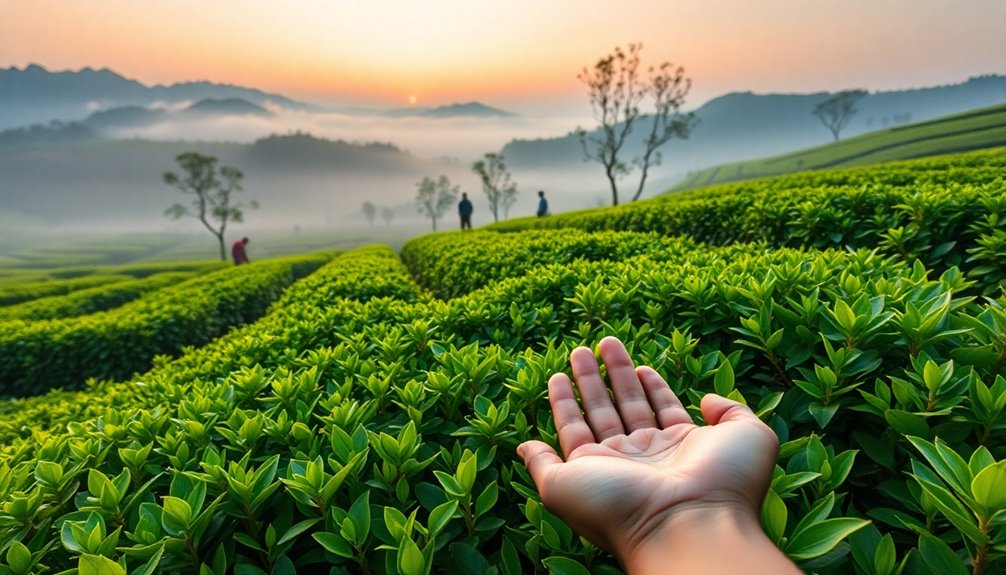
How do different tea leaf plucking techniques impact the final flavor of your brew? It's all about how the leaves are harvested!
Hand-harvesting, often used in places like China and Japan, focuses on picking the youngest and most delicate leaves. This method leads to a superior flavor and aroma in the tea you drink.
On the other hand, mechanical harvesting, common in regions like Kenya and Sri Lanka, can mix up leaf qualities, which may hurt the overall flavor profile. Some plucking techniques in India and Sri Lanka use sharp blades, causing more damage to the tea bushes. This can affect the health of the plants and the quality of the leaves.
Traditional methods, like hand-picking, help preserve unique qualities and flavors that mechanical techniques can't match.
Plus, seasonal variations play a crucial role in flavor, with the first flush of leaves often being the most prized.
Plucking Timing Influences Flavor
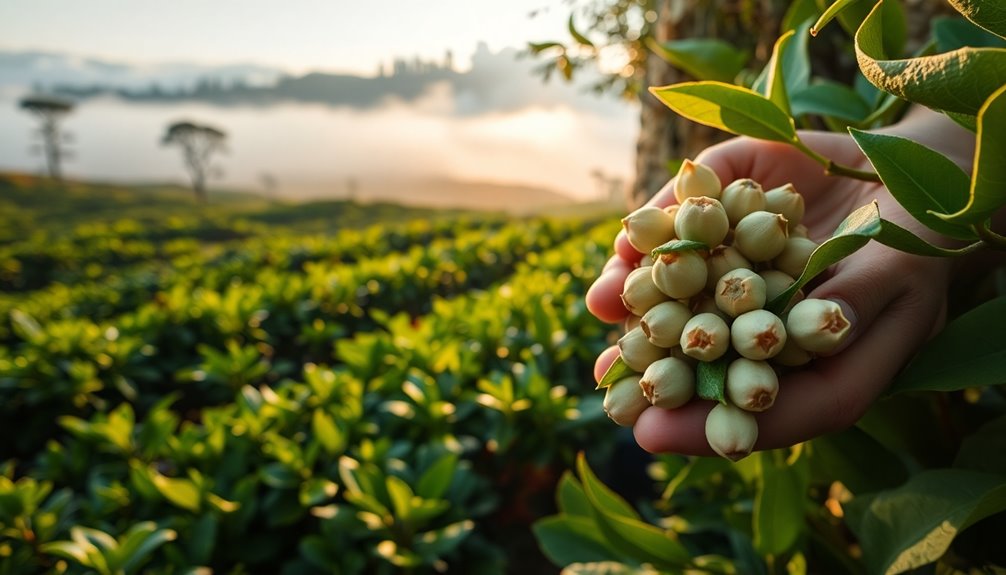
The timing of tea harvesting significantly impacts the flavor of your brew, with the first flush of leaves being the most sought after. When tea farmers pick leaves during the first flush, right after winter, they gather the sweetest and most nutrient-rich leaves. This is because these young leaves grow under the best conditions, allowing them to pack in a high concentration of flavor compounds.
During spring, the tea plant awakens, and this is when the shincha harvest happens. The leaves collected during this time are special and often cost more because of their exceptional taste. If tea farmers wait too long to harvest, the flavor and aroma compounds start to decline. Each plucking after the first flush usually results in lower quality leaves.
Farmers carefully consider their plucking timing, knowing that tender young leaves create the best flavor profile for your favorite brew.
Impact of Altitude on Flavor
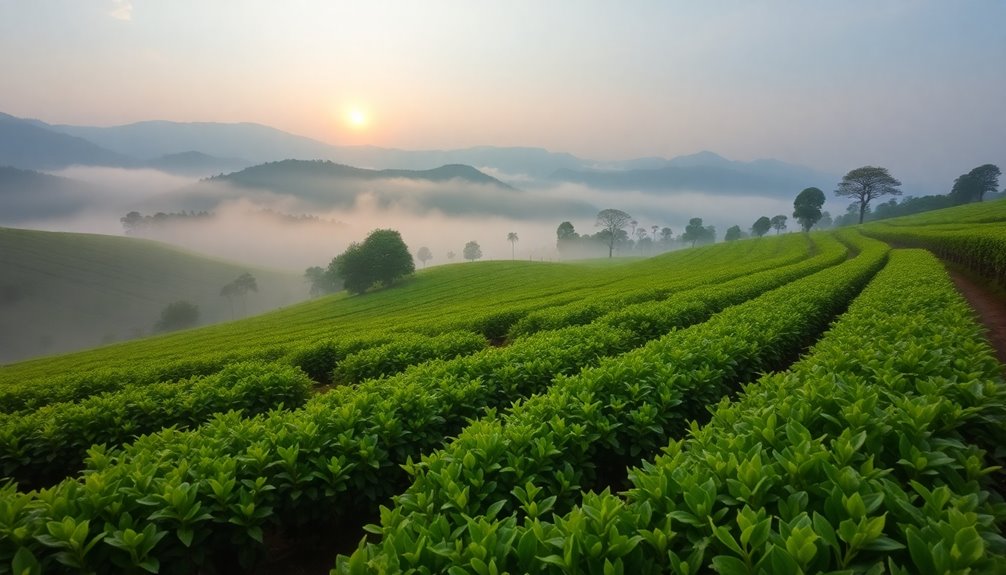
Although many factors influence the flavor of tea, altitude plays a crucial role in shaping its taste profile. When you think about tea plants like Camellia sinensis, remember that higher altitudes usually mean cooler temperatures. This slower growth leads to denser leaves that pack more flavor!
Plus, at elevated locations, tea plants get more sunlight, which helps develop those delightful aromatic compounds that make tea so special. The soil at these heights is often mineral-rich, adding even more complexity to the tea's taste.
When tea is harvested from higher elevations, studies show it tends to have less bitterness and much more sweetness. This sweet balance makes it extra appealing to both everyday drinkers and tea connoisseurs.
Famous tea regions like Darjeeling in India and Uji in Japan are great examples. Their high-altitude environments contribute to uniquely flavored teas that are loved worldwide.
Labor Disputes in Tea Harvesting
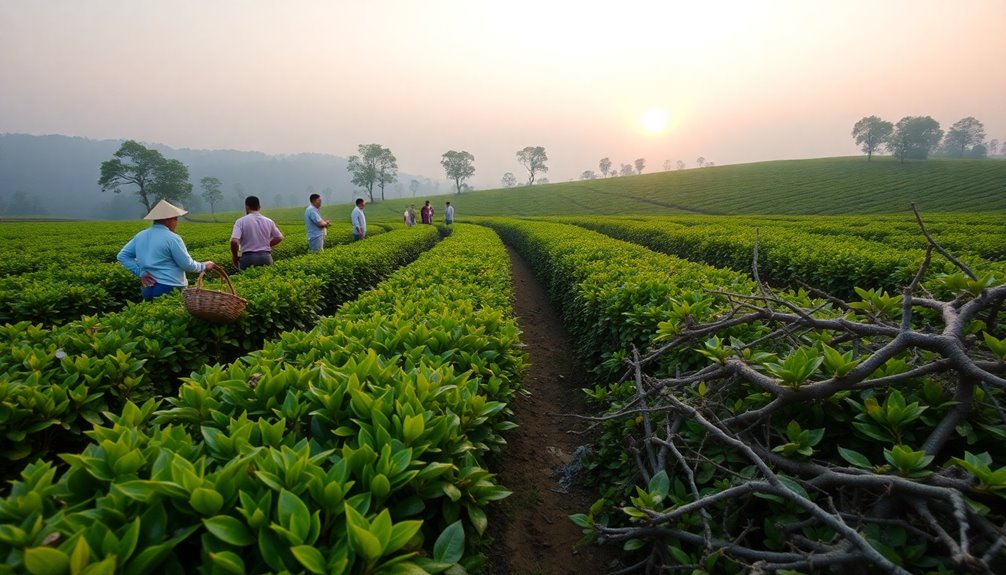
While enjoying a cup of tea, it's important to recognize that the quality of the leaves isn't just influenced by altitude and growing conditions; labor disputes in tea harvesting also play a significant role.
These disputes often happen due to low wages and poor working conditions. Workers in places like Sri Lanka and India sometimes strike or protest, which can stop tea harvesting temporarily. This affects the tea supply and can even change prices around the world!
Many tea plantations rely on seasonal migrant labor. These workers often face job insecurity, making them more vulnerable to disputes.
When companies encounter these issues, they might switch to mechanical harvesting. This choice can hurt traditional methods, leading to lower tea quality.
Negotiations between plantation owners and labor unions are crucial to finding solutions. By working together, they can ensure fair wages and better working conditions.
This teamwork helps maintain the high quality we love in hand-harvested tea. So, next time you sip your tea, remember that the journey from leaf to cup is filled with challenges, and every drop reflects the hard work of many hands.
Practical Applications
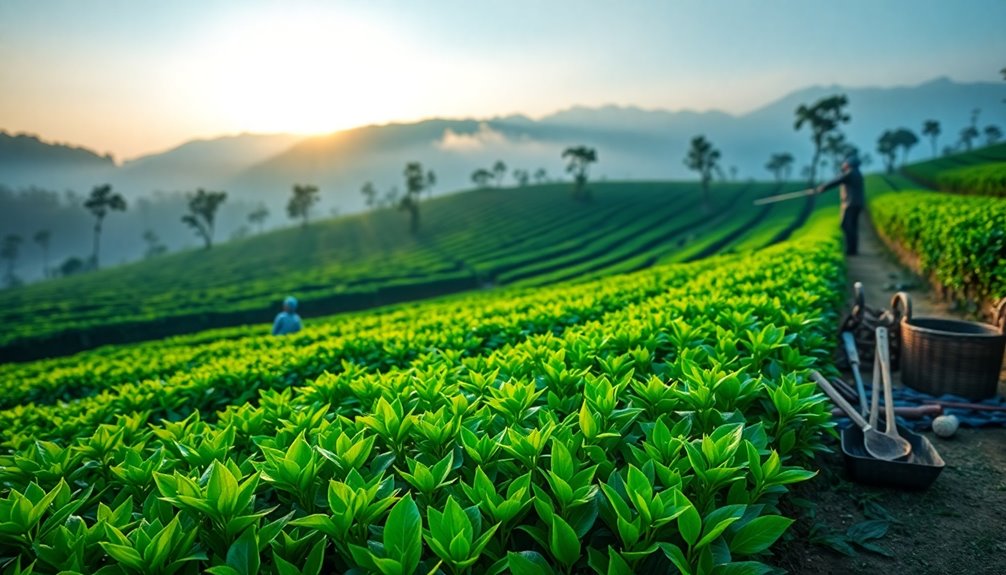
Harvesting tea isn't just a routine task; it's an art form that significantly impacts the final product. When you think about tea, especially black tea, consider how it's harvested. Using traditional methods like hand picking allows for the selection of the youngest, most delicate leaves. This choice boosts the flavor profile and aroma of your tea.
Timing is key, too! The first flush in spring is when tea plants are full of nutrients, making those leaves extra special. If machines do the harvest, they can't tell which leaves are the best, leading to a mix that can taste less delightful.
Moreover, hand picking means less damage to the tea bushes, preserving the unique qualities of each leaf. This careful handling influences the tea's chemical composition, especially during rolling and drying, which can change the flavor.
These practices not only create a better tasting tea but also provide health benefits. So, the next time you sip your favorite cup, remember that the way tea is harvested plays a huge role in that delicious experience! Enjoy every drop!
Frequently Asked Questions
What Factors Affect Tea Fermentation?
Several factors affect tea fermentation, including oxidation time, temperature, humidity, and processing techniques. By controlling these elements, you can significantly influence the flavor profile and complexity of the tea you enjoy.
What Are the Methods of Harvesting Tea?
You can harvest tea using traditional hand-picking or mechanical methods. Hand-picking lets you select the finest leaves, while machines gather quickly but may mix leaf quality, impacting the overall outcome of the tea.
How Does Tea Get Its Flavor?
Tea gets its flavor from the specific leaves you choose, their age, and the conditions they grow in. The careful selection of young leaves during harvest enhances the aromatic compounds that create a rich, enjoyable taste.
What Factors Influence Tea Quality Before Processing?
The quality of tea before processing hinges on harvest timing, seasonal changes, and leaf selection. You'll notice that younger leaves and environmental factors like soil and climate directly influence the tea's overall flavor and aroma.
Conclusion
In conclusion, the way tea is harvested really matters! Different plucking techniques, the timing of when leaves are picked, and even the altitude can change the flavor of your favorite tea. Plus, labor disputes can impact the quality, too. So, next time you sip on a warm cup of tea, remember all the hard work and choices behind it. Every cup tells a story, making it even more special. Enjoy discovering the flavors of tea!


